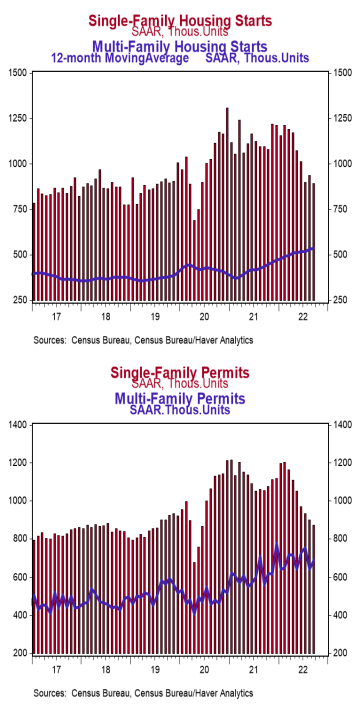- Housing starts declined 8.1% in September to a 1.439 million annual rate, lagging the consensus expected 1.461 million. Starts are down 7.7% versus a year ago.
- The drop in September was due to both single-family and multi-unit starts. In the past year, single-family starts are down 18.5% while multi-unit starts are up 17.6%.
- Starts in September fell in the South, Northeast, and Midwest, but rose in the West.
- New building permits rose 1.4% in September to a 1.564 million annual rate, beating the consensus expected 1.530 million. Compared to a year ago, permits for single-family homes are down 17.3% while permits for multi-unit homes are up 23.4%.
Implications:
Following a brief rebound in August, housing starts resumed their decline in September as relatively high mortgage rates, labor shortages, and ongoing supply-chain issues continue to weigh on builders. Looking at the details, both single-family and multi-unit construction contributed to the headline decline. It is clear developers are becoming more cautious about future demand for new single-family projects with 30-year mortgage rates now above 7.0% and are continuing to focus resources on apartment buildings, instead. Over the past year single-family starts are down 18.5% versus multi-unit starts, which are up 17.6%. Though groundbreaking on new residential projects is now down 20.3% from the peak earlier this year, keep in mind that construction overall has hardly ground to a halt. Lots of projects are already in the pipeline, with the number of homes under construction at the highest level on record back to 1970. These figures demonstrate a slower construction process due to a lack of workers and other supply-chain difficulties. Despite this, building permits for new projects rose a modest 1.4% in September due to the multi-unit sector. The backlog of projects that have been authorized but not yet started is currently just below the record high since the series began back in 1999. Meanwhile, homebuilder sentiment, as measured by the NAHB Housing Index, is deteriorating. The index fell for a tenth consecutive month to 38 in October. An index reading below 50 signals that more builders view conditions as poor vs. good. The prime concern continues to be higher mortgage rates, which are having a negative impact on potential sales as certain buyers are at least temporarily priced out of the market, leaving some builders with a surplus of inventory. Housing isn’t going to be a source of economic growth in the year ahead, but do not expect a housing bust nearly as harsh as in the 2000s. Unlike the previous housing bust, we do not have a massive oversupply of homes.





